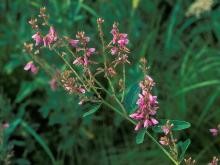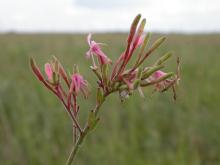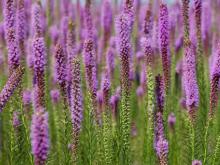Wildflowers, Grasses and Other Nonwoody Plants
Media

Species Types
Scientific Name
Liatris aspera
Description
Rough blazing star is fairly common and scattered nearly statewide. To distinguish between Missouri’s nine species in the genus Liatris, start by noting details of the flower structure. It’s not hard when you know what to look for.
Media

Species Types
Scientific Name
Pueraria montana
Description
Of the many invasive nonnative plants that were originally introduced to stop soil erosion and improve soils, kudzu is one of the worst. This “vine that ate the South” is often the first plant that comes to mind when we think of “invasive plants.”
Media

Species Types
Scientific Name
Lespedeza cuneata
Description
Decades ago, sericea lespedeza was introduced in hopes it would provide hay, improve pastures, stop soil erosion, and supply food and cover for wildlife. Unfortunately, it has proven to be an aggressive, invasive weed that is extremely difficult to control, escapes cultivation, and outcompetes native plants.
Media

Species Types
Scientific Name
Lespedeza virginica
Description
A bushy native perennial legume with small clusters of pink flowers, slender bush clover provides nectar for numerous insects. Several types of birds eat the seeds, and many mammals eat the foliage.
Media

Species Types
Scientific Name
Fallopia scandens (formerly Polygonum scandens)
Description
Climbing false buckwheat is a rampant, native, annual or perennial climber that often forms curtainlike masses of twining red stems, covering shrubs and trees. Look for it in moist, open or shaded bottomlands, alluvial valleys, and floodplains.
Media

Species Types
Scientific Name
Desmodium spp. (17 species in Missouri)
Description
Missouri has 17 species of tick trefoils, which live in a variety of habitats. Hikers know them well from their chains of hairy little seedpods that stick to clothing like parasites!
Media

Species Types
Scientific Name
Oenothera filiformis (formerly Gaura longiflora, G. biennis)
Description
Large-flowered gaura is a tall plant whose white flowers turn pinkish as they age. Four petals point upward, then bend back, and 8 stamens droop downward. The flowers look something like small butterflies.
Media

Species Types
Scientific Name
Liatris pycnostachya
Description
Prairie blazing star has an unbranched stalk with many densely crowded, rose-purple flowerheads. It is a signature wildflower of the tallgrass prairie.
Media

Species Types
Scientific Name
Persicaria virginiana (formerly Polygonum virginianum)
Description
Virginia knotweed, or jumpseed, is common yet rarely contemplated. It might be most eye-catching in spring, when its new, oval leaves are marked with brownish Vs. In summer, it blooms with tiny, teardrop-shaped white flowers on wandlike stems.
See Also
About Wildflowers, Grasses and Other Nonwoody Plants in Missouri
A very simple way of thinking about the green world is to divide the vascular plants into two groups: woody and nonwoody (or herbaceous). But this is an artificial division; many plant families include some species that are woody and some that are not. The diversity of nonwoody vascular plants is staggering! Think of all the ferns, grasses, sedges, lilies, peas, sunflowers, nightshades, milkweeds, mustards, mints, and mallows — weeds and wildflowers — and many more!





















